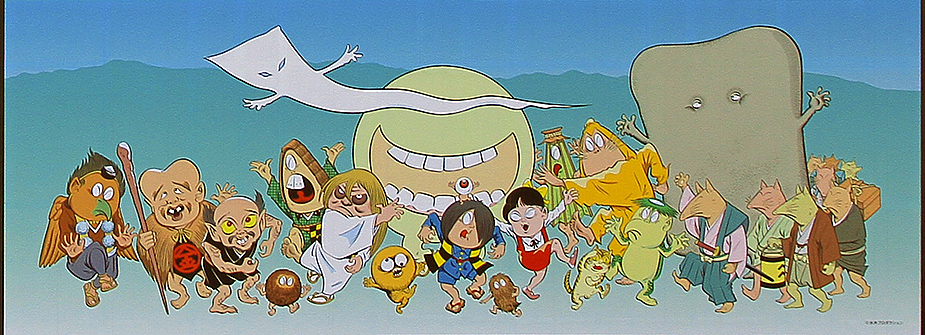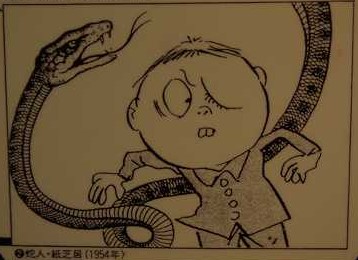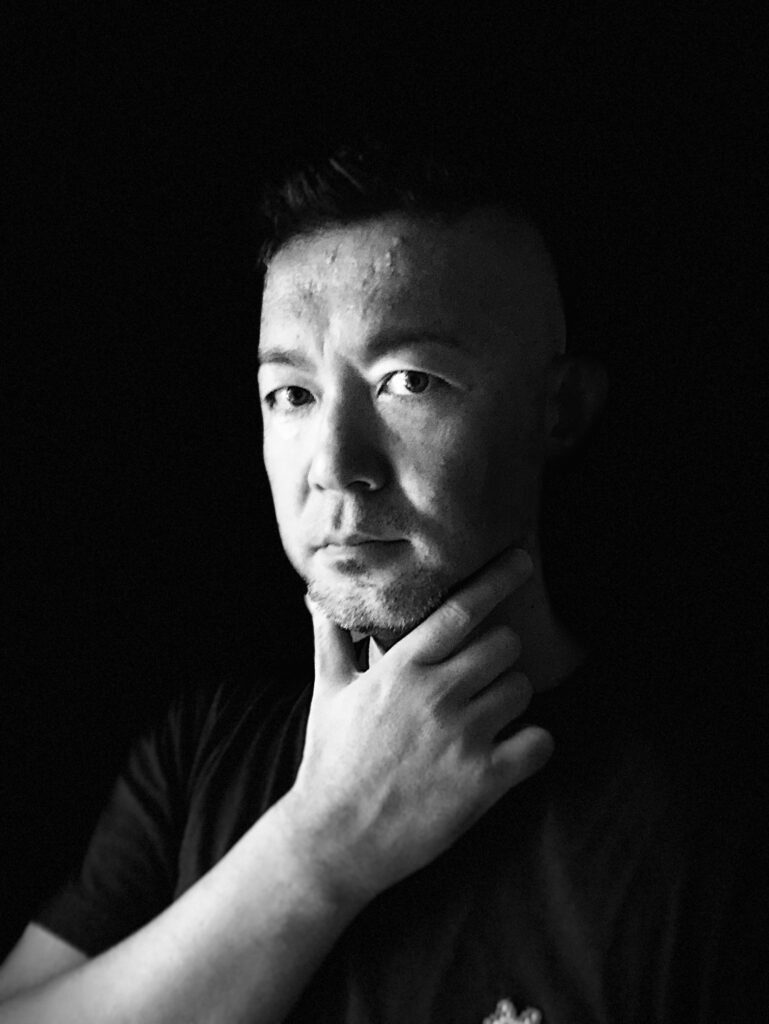Past and Future of Nippon Subculture ~No.6 Mononoke PartyⅡ~
ニッポン・サブカルチャの”過去と未来”と謳いながらも、未来どころか現在に辿り着くことも覚束ないこの連載です、コバヤシです。前回は、妖怪が如何に時代の変遷と共にヴィジュアル化され、サブカルチャとして日本に根付いてきたかということと、妖怪を具現化してきた語り部たちの話でした。今回は前回からの続きで、(ようやく)現代における妖怪の語り部の話です。
This is a series of articles that says “past and the future” of Japanese subculture, but we can’t even get to the present, or even the future. Hi I’m Kobayashi. In my last article, I talked about how yokai have been visualized over time and have taken root in Japan as a subculture, and about the storytellers who have embodied yokai. In this article, I will continue from the previous article and (finally) talk about the storytellers of yokai in the modern age.
現代日本の妖怪語り部としてまずあげられるのが『ゲゲゲの鬼太郎』の作者(故)水木しげる氏です。
The first person to be mentioned as a yokai storyteller in modern Japan is Shigeru Mizuki, the (late) creator of “Gegege no Kitaro”.

水木しげる氏の大きな功績は大きくわけて二つあると思います。
I think there are two major achievements of Shigeru Mizuki.
僕は(当然)水木氏と個人的な面識があるわけではありませんが、当人も大分ユニークなキャラクタだったようで、『ゲゲゲの鬼太郎』の主題歌そのままに朝寝を好んでいたり、座談が面白いことで有名で、多忙な水木のために水木プロには「面談30分」という貼り紙があったが、実際には水木自身がそれを無視して来客と何時間も会話を楽しんでいたといいます。さらにアフリカ・マリ共和国のドゴン族、マレーシアの夢を自由に見られるセノイ族、オーストラリアのアボリジニ、メキシコのインディオたちの村、アメリカの先住民・ホピ族の村など、世界のあちこちに「冒険旅行」と称したフィールド・ワークに行き、各地のスピリチュアル文化に触れて「妖怪を感じて」いたそうです。マレーシアのジャングルで、現地人に著作『日本妖怪大全』を見せたところ、「これは知っている」「これも知っている」と、猛烈な反応があったそうです。
水木氏の漫画には水木氏自身が登場することもよくありますが、そこで水木氏自身が精霊/妖怪に出会ったり、大国主命が夢枕に立ったりしています。水木氏自身が霊的なものが“視えるひと”だったようです。ちなみに僕はそういう霊的なものを視たり体験したことはありませんが、スタンスとしては「現在科学でわかっていること、見えているものがすべてではない」というものです。精霊・妖怪・霊がなんらかのエネルギーであれば、かならず固有の波長をもっているはずです。そしてその波長に意図的に、無自覚にチューンできてしまう人間もいると思います。そうしたシャーマニックな性質と圧倒的な画力が合わさって、妖怪語り部水木氏/水木作品が生まれたことは、日本の文化にとって大変幸運なことだったと思います。
I don’t have any personal acquaintance with Mizuki (of course), but it seems that he was a very unique character, who liked to sleep in the morning, just like the theme song of “Gegege no Kitaro”, and he was famous for his interesting informal conversations, and although there was a sign posted at Mizuki Productions saying “30 minutes for interviews” for Mizuki’s busy schedule, Mizuki himself actually ignored it and enjoyed hours of conversation with visitors.He also went on fieldwork called “adventure travel” to many places in the world, such as the Dogon tribe in Mali, Africa, the Senoi tribe in Malaysia who can see dreams freely, the Aborigines in Australia, the Indians in Mexico, and the Hopi tribe in the United States. He says that he was able to “feel the yokai” by coming into contact with the spiritual culture of each place.In the jungles of Malaysia, when he showed his book “NIHON Yokai Taizen” to the locals, they had a strong reaction, saying “I know this one” and “I know that one too.
In his manga, Mizuki often appears as himself, where he himself meets spirits and yokai, and Okuninushi no Mikoto stands on his dream pillow. It seems that Mizuki himself was a person who could “see” spiritual things. By the way, I have never seen or experienced such spiritual things, but my stance is that “what we know and can see today is not everything”. If spirits, yokai, and ghosts are energy of some kind, they must have their own wavelength. And I believe that there are people who can tune into those wavelengths intentionally and unconsciously. I think it is very fortunate for Japanese culture that such a shamanic nature, combined with overwhelming drawing ability, has given birth to the yokai storyteller Mizuki and his Mizuki works.
『ゲゲゲの鬼太郎』(以下:キタロー)は漫画・アニメをはじめとし、実写映画、舞台、ミュージカル、小説、ラジオドラマとありとあらゆるメディアで作品化されているので、多くの人が楽しんだことがあると思います。キタローのおかげでついに妖怪たちは昭和の時代において国民的なエンターテインメント、サブカルチャとなったのです。しかしキタローも最初から大人気のキャラクターだったわけではありません。
Many people have enjoyed “Gegege no Kitaro” (hereinafter referred to as “Kitaro”) because it has been made into all kinds of media, including manga, anime, live-action movies, stage shows, musicals, novels, and radio dramas. Thanks to Kitaro, yokai have finally become a national entertainment and subculture in the Showa era. However, Kitaro was not always a very popular character.
キタローが水木氏によって生み出されたのは1954年(昭和29年)、紙芝居としてでした。(ちなみに「紙芝居」は、物語ごとに複数枚を一組に重ねた絵で、その絵を一枚ずつ出して見せつつ演じ手が語りながら進める芝居的な芸能/サブカルチャです。紙芝居屋は自転車に紙芝居と水飴などの駄菓子を積んで街頭を回って、拍子木を打ったり法螺貝を吹いたりして子供を集めて駄菓子を売り、人数が集まれば紙芝居を始めていたそうです。僕も世代的に実際に観たことはありません)水木氏はオリジナルの紙芝居物語「墓場の鬼太郎」として、『蛇人』『空手鬼太郎』『ガロア』『幽霊の手』の4作を仕立て、これがキタローシリーズの原点となりました。
Kitaro was first created by Mizuki in 1954 as a picture story show. (Incidentally, “kamishibai” is a theatrical art/subculture in which multiple pictures are piled up in a set for each story, and the performer tells the story while showing the pictures one by one. The storyteller would go around the streets with a bicycle carrying a picture-story show and candy canes, hitting the clapperboard or blowing the conch shell to attract children and sell them candy and, when enough children showed up, the storytelling would start. I have never actually seen a picture-story show because of my generation.) Mizuki created four original “Graveyard Kitaro” picture-story shows: “Jajin (Snake Man),” “Karate Kitaro,” “Galore,” and “Yurei no Te(Ghost’s Hand),” which became the starting point of the Kitaro series.


鬼太郎は墓場から生まれた片目の幽霊族の少年、目玉おやじの登場等は最初期から設定としてありました。その後1960年(昭和35年)、水木氏は貸し本漫画家に転身し、怪奇短編漫画雑誌『妖奇伝』に「幽霊一家」を発表します。ここで現在まで続く鬼太郎のイメージが固まりました。しかし、この時期の鬼太郎はまだ人間の味方ではなく、関わった人々に怪奇な結末をもたらす不吉な少年という位置づけでした。
Kitaro was a one-eyed ghost boy born from a graveyard, and the appearance of the eyeballed oyaji, etc. were set from the very beginning. Later, in 1960, Mizuki became a rental book cartoonist and published “Yurei Ikka (Ghost Family)” in “Yokiden,” a weird short comic magazine. It was here that the image of Kitaro that continues to this day was solidified. At that time, however, Kitaro was still positioned as a sinister boy who brought bizarre consequences to those involved with him, not as a friend of humans.

1965年(昭和40年)、『週刊少年マガジン』(講談社)での「墓場の鬼太郎」読み切り掲載、不定期掲載、1967年(昭和42年)からの正式な連載作品への昇格を経て、キタローは1968年(昭和43年)にアニメ化されます。アニメ化に関しては週刊少年マガジンに不定期掲載されていた頃から試みがありましたが、「妖怪もので、タイトルが墓場ではちょっと……スポンサーが付かないから」
という理由で実現していませんでした。しかしタイトルを『墓場の鬼太郎』から『ゲゲゲの鬼太郎』に変更することでスポンサーの了解を得て、内容も「怪奇物語」から「正義の鬼太郎が悪い妖怪を退治する」という少年誌/アニメ向けの内容に変化していくことで、アニメ化を達成、キタローは子供たちのヒーローになっていきます。ちなみに「ゲゲゲ」の由来は、水木氏が幼い頃に自分の名前を「しげる」と言えずに「ゲゲル」「ゲゲ」と言っていたことから着想したものとのことです。
In 1965, “Graveyard Kitaro” was published as a read-along in Weekly Shonen Magazine (Kodansha), published irregularly, and then promoted to an official serial work in 1967. After that, Kitaro was made into an anime in 1968. There was an attempt to make it into an anime when it was published irregularly in Weekly Shonen Magazine, but it didn’t happen because “it’s a yokai story and the title is “Graveyard”, so it wouldn’t get any sponsors……. However, by changing the title from “Graveyard Kitaro” to “Gegege no Kitaro” and getting the sponsor’s approval, as well as changing the content from a “bizarre story” to a “righteous Kitaro exterminating bad monsters” for boys’ magazines and anime, the anime adaptation was achieved and Kitaro became a hero for children. Incidentally, the origin of “Gegege” was inspired by the fact that Mizuki could not say his own name “Shigeru” when he was a child, but instead said “Gegel” or ” Gege”.
僕がリアルタイムで見ていたアニメは1985年からの第三期ですが、もっと幼い時に観たもので記憶に残っている、トラウマになっているものがあったので記憶を辿ってリサーチしてみたところ、発見しました。アニメ第二期、第43話『足跡の怪』の回です。内容は「とある農村にはタイタン坊という妖怪をまつる守護石があった。科学者の中村と山田はそれを隕石とみて、一部を叩き割って持ち帰る。その日から恐ろしい祟りが起こり始める。鬼太郎はタイタン坊の怒りを鎮めるため、中村たちに石を返すよう説得に向かうが、功名心に憑かれた中村は聞く耳を持たない。そのうちに、祟りは二人の身にも及び始める。山田の肉体が少しずつ崩壊し始めたのだ…。」マニアからの評価が高いトラウマ回だったようで、祟りによって肉体が崩れていく様は今も鮮烈に覚えています。(より詳しい内容はこのブログにありました。)
The anime I watched in real time was the third season from 1985, but there was something I watched when I was much younger that I remembered and was traumatized by, so I tried to research through my memory and found it.This is the second season of the anime, episode 43, “The Mystery of the Footprints”. The content of the episode is as follows: “In a certain farming village, there was a guardian stone for a demon called Titan Boy. Scientists Nakamura and Yamada think it is a meteorite and smash a part of it and take it home. From that day on, a terrible haunting begins to occur. Kitaro goes to persuade Nakamura and the others to return the stone to quell Titan-boy’s anger, but Nakamura, possessed by a sense of merit, refuses to listen. Eventually, the haunting begins to take its toll on both of them. Yamada’s body begins to slowly disintegrate…” It was a traumatic episode that was highly praised by maniacs, and I still vividly remember the way the body collapsed due to the haunting. (For more details, please refer to this blog : Japanese only)
勧善懲悪をストーリーに導入することにキタローはヒーローになっていったわけですが、常に妖怪が悪者というわけではありません。妖怪が人間による開発の被害者だったり、人間やねずみ男に利用されて騒ぎを起こすといった、時代・世相を反映した風刺色の強いストーリの回があったり、怪奇色の強い水木作品の持つピュアなエッセンスを忠実に映像化している回も多くあります。このバックボーンにあるのは、水木氏の妖怪への、目に見えぬ存在たちへの愛、そしてそれを汲み取ったアニメ制作スタッフの努力だと思います。こうした要素がキタローを、子供だけでなく、大人も作品に惹きつけ、時代を超えて愛される作品にしています。
The introduction of “poetic justice” into the storyline has made Kitarou a hero, but it does not mean that yokai are always the bad guys. There are times when yokai are victims of human development, or when they are used by humans or the mouse man to cause trouble, etc. There are times when the story has a strong satirical tone that reflects the times and the world, and there are many times when the pure essence of Mizuki’s works with strong bizarre elements is faithfully visualized.I believe that the backbone of this work is Mizuki’s love for yokai, invisible beings, and the efforts of the animation production staff to capture this love. These elements are what make Kitaro a work that attracts not only children but also adults, and is loved throughout the ages.
水木氏は非常に多作でキタロー以外にも多くの作品を残しています。もうひとつの代表作である「悪魔くん」をはじめ、「河童の三平」などの妖怪もの。自信の戦争体験を漫画化した「総員玉砕せよ!」。古典を題材とした「水木しげるの泉鏡花伝」、「今昔物語」、「東海道四谷怪談」など。日本神話を題材とした「水木しげるの古代出雲」では『古事記』や『出雲国風土記』などの神話や史実を交え、オオクニヌシの視点で古代出雲王国の盛衰を描いています。作中に梅原猛氏も登場することから史観の影響があったのかな、と僕は推測しています。勝者(ヤマト王朝)の視点、歴史観では「国譲り」となっている権力の移譲も「実際にはキレイ事じゃなかっただろう」と語られています。神話からさらに時代を遡り、縄文時代を舞台とした!!「縄文少年ヨギ」という作品もあります。最初の単行本は1976年にされていて、フィクションということもあり、現在の考古学的視点の縄文とはことなりますが、飢えや死と向き合いながら様々な冒険をするヨギの姿、カミや精霊との交流の描かれ方は非常に僕の考える「縄文」に近いものがあります。
Mizuki is a very prolific writer and has left behind many other works besides Kitaro. His other masterpiece, “Akuma-kun,” is one of his most popular works, as well as “Kappa no Sanpei” and other stories about yokai. He also wrote a comic book based on his own war experience, “Onward Towards Our Noble Deaths”. The classics include “Mizuki Shigeru’s Senkyoukaden,” “Konjaku Monogatari,” and “Tokaido Yotsuya Kaidan.”In “Mizuki Shigeru’s Ancient Izumo,” based on Japanese mythology, he depicts the rise and fall of the ancient Izumo Kingdom from the perspective of Okuninushi, using myths and historical facts from “Kojiki” and “Izumokuni Fudoki.Since Takeshi Umehara also appears in the story, I suspect that he was influenced by the historical view. From the perspective of the victor (the Yamato Dynasty), the transfer of power, which in the historical perspective is called “handing over the country,” is described as “probably not a pretty thing in reality”. There is also a work called “Jomon Shonen Yogi,” which is set in the Jomon period, further back in time from the myth. The first book was published in 1976, and although it is a work of fiction, and therefore different from the current archaeological view of the Jomon, the way it depicts the yogi’s various adventures while facing hunger and death, and their interactions with kami and spirits, is very close to my idea of the Jomon.
今回で妖怪の話は終わりの予定だったのですが、書き始めたらヴォリューム一杯になってしまったので、次回に続きます。
This was supposed to be the end of the yokai story, but I started writing and the volume filled up, so I’ll continue next time.

小林 武人 ポストデジタル・アーティスト
Taketo KOBAYASHI
Post-digital artist
ARTSTATION
Taketo Kobayashi (artstation.com)
Instagram ID
@humanoise
NPO法人JOMONISM 代表
https://humanoise.artstation.com
慶應義塾大学 環境情報学部卒。東京工科大学クリエイティブ・ラボ、株式会社ゴンゾを経てフリーランスに。現在は“ポストデジタル・アーティスト”として、CGや3Dプリント等のデジタルツールを“筆”として使いこなし、立体作品から映像まで幅広く制作。海外でも積極的に活動しており、美術家 坂巻善徳 a.k.a. senseとのコラボレーションプロジェクト“XSENSE”では、デジタル作品をストリートアートに活かし、ミューラル(壁画)を制作(コロラド州、デンバー)。また、独自の世界観のアニメーションを舞台美術として使い、コンテンポラリー能劇団とコラボレーションで公演も行った(サンフランシスコ、デンバー)。
自身の作品制作の他に、NPO法人JOMONISMが行う”ARTs of JOMON”展のキュレーションも担当。縄文文化から影響を受けた現代美術作家を世界に紹介し続けている(青森県立美術館、スパイラルガーデン、デンバー国際空港、クアラ・ルンプール等)。
目に見えないモノ、感情、エネルギー、意識の次の次元…等をカタチにすることがミッション。
現在はシンガポール在住
After having experience of 3D graphics and animation at Tokyo Institute of Technology creative laboratory, and Gonzo Co., Ltd., Taketo started his own project as an artist. Using digital technology like CG, 3D printing as his “brush”, Taketo creates a wide variety of artworks from 3D printed sculpture to animation. In a collaboration project XSENSE, Taketo utilizes CGI in street art to create murals(Denver, CO, USA), also using his unique style animation for stage design and collaborated with contemporary Noh theatrical group. In addition to creating his own artworks, Taketo curates the group art show “ARTs of JOMON” hosted by Japanese non-profit JOMONISM, keep introducing contemporary artists/artworks influenced by ancient Japanese Jomon culture.(Aomori Museum of Art / Spiral Garden / Denver International Airport / Kuala Lumpur)
It is Taketo’s mission to make invisible things, emotions, energy, next dimensions of consciousness into “shapes”.
職歴・作品履歴(抜粋)
2004年
TVアニメーション「岩窟王」:背景デザイン、モデリング担当
2005年
スズキ「バーグマン」WEBプロモーション:バーグマン、モデリング担当
2007年
NHK アニ・クリ「火男(ヒョットコ)」:デザイン、モデリング担当
2012年
「MYSTICAL ABYSS」
アメリカ、サンフランシスコ、コンテポラリー能劇団Theatre of Yugenの公演、Mystical Abyss でオリジナルアニメーション制作、ライブプロジェクション担当
2013年-
アメリカ、デンバー、Art Across Cultures, Hope Onlineなどと共同で公演に参加。デンバーアート・ミュージアム等でアニメーションのプロジェクションを担当
2014年
2月 NPO法人JOMONISM企画「ARTs of JOMON展」@青森県立美術館、キュレーション担当
5月 シンガポール南洋工科大学3DPコンペティション参加。カンファレンス招待
11月 企業コラボーレションアート参加:オークリーストア原宿店にて作品展示
2015年
1月 NPO法人JOMONISM企画「ARTs of JOMON展」@スパイラルガーデン、キュレーション担当
2017年
“ARTs of JOMON -Hyper Subculture-” 展 キュレーション担当
伊勢丹 the ジャパンストア、クアラルンプール、マレーシア
2018年
”YouFab Exhibition – Imagination Manifests”@青年廣場 HongKong “More Than Human”プロジェクト、3Dプリント義足を展示
2019年
グループ展『童心』出展 銀座ホワイトストーン・ギャラリー
2020年
「Lights to the Night」アーティストに選出。シンガポール、アジア文明博物館にプロジェクション・マッピング
受賞歴等
オリジナルアニメーション『祭』(2010)
シーグラフ・アジア アニメーションシアター入選
YAOYOROZシリーズ『薬師如来』(2013)
3Dプリント用3DCG作品。日本図学会モデリングコンテスト、入賞
『SC1-EXP』(2014)
3Dプリント作品に映像をプロジェクション・マッピングしたインタラクティブ作品。
逗子国際プロジェクション・マッピング・フェスティバル、グランプリ
More Than Human『type-Unicorn』(2015)
3Dプリント義足。Ufab Global Creative award、ファイナリスト
“Eisen Herz”(2016)
構造計算を用いた3Dプリントミニ四駆カヴァー
Ufab Global Creative award、ファイナリスト
Project/Art history(excerpt)
PROJECTS Digital G-O-D, UltraSuperNew gallery, Singapore, Jan 2020
Haw Par Villa RE•MIX
Chinese Cultural Centre, Singapore , Jan 2020
”Light to Night Festival” Projection mapping at Asian Civilization Museum, Singapore , Jan 2020
A SIGN OF THE TIMES EXHIBITION, Singapore , Jan 2019
”ARTs of JOMON” exhibit @ISETAN KL, Malaysia , Aug 2017, curation&direction
“Colorado Crush”, a mural festival in Denver, CO. Sept 2016, created artwork
“DMS” Collaboration with Canon June 2015, created&exhibited 3D printed prosthetic leg
”Oakley Exhibition” Exhibited artworks at Oakley store Harajuku, Tokyo, Oct 2014
AWARDS “Eisen Herz” Ufab Global Creative award Finalist. 2016. 3D printed cover for “Tamiya mini 4WD” using generative design
“More Than Human type-Unicorn” a 3D printed prosthetic leg. Ufab Global Creative award Finalist. 2015
“SC1-EXP” Zushi International Projection Mapping Competition, Grand Prix. 2014
“Yakushi-Nyorai”(2013)
3DCG model for 3D printing. Winning work at Digital modeling competition held by Japan Society for Graphic Science
Original CG animation ‘Matsuri’(May 2010)
Design, modeling, production coordination. A CG animation based on Japanese ‘Jomon’ culture. Created for promotion of Aomori Prefecture. Accepted at Siggraph Asia 2010. (On VIMEO: https://vimeo.com/25144961)